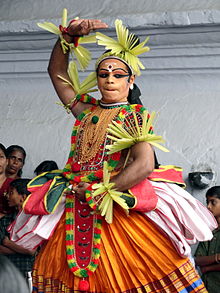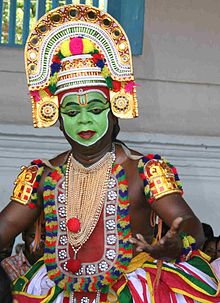Ottamthullal or Ottanthullal (Malayalam:ഓട്ടന്‍ തുള്ളല്‍, is a type of performing art from Kerala, India. The art form was created during the 18th century by legendary Malayalam poet Kalakkaththu Kunchan Nambiar. The story goes that Nambiar, who was playing the mizhavu for a Chakyar Koothu show, dozed off in the middle of the performance, thus inviting ridicule from the Chakyar. A humiliated Nambiar vowed to come up with an alternative art form to Chakyar koothu, and conjured up an Ottamthullal show that also made fun of prevalent socio-political equations and prejudices of the region.

The art form still retaThe story was ΓÇ£Kallyana SougandhikamΓÇ¥ an extract from Mahabharata where Lord Bhima travels to collect a rare flower by name kallyana sougandhikam. And see his elder brother Hanuman on the way and got engaged in lengthy conversations as Bhima does not recognizes his brother etc. It was the language people heard for the first time in a performance which had none of the unusual intricacies of Sanskrit. People were thrilled to hear the verses in the plain language they use in their day today life.
Kunchan Nambiar lavishly used the similes to insult the land lords and other so called very reputed personalities of that time as BhimaΓÇÖs image was pictured like them foolish and arrogant landlord. People were thrilled but the chakyar was not. He went to the king and complained against Nambiar. The king of Chembakassery who knew about the pranks of Kunjan Nambiar and ordered that from that day onwards no ΓÇ£thullalΓÇ¥ will be performed in the Ambalapuza temple compound.(even now this order is obeyed by the temple).
called very reputed personalities of that time as BhimaΓÇÖs image was pictured like them foolish and arrogant landlord. People were thrilled but the chakyar was not. He went to the king and complained against Nambiar. The king of Chembakassery who knew about the pranks of Kunjan Nambiar and ordered that from that day onwards no ΓÇ£thullalΓÇ¥ will be performed in the Ambalapuza temple compound.(even now this order is obeyed by the temple).
But the king did not ban the art as it is in the case of the present ministers. The thullal performances and the lyrics used in it spread like wild fire it became an essential performance in all temple festivals barring the Ambalapuzha temple.
The art of thullal was not created from the vacuum. Kunjan Nambiar adopted much from the existing tribal performances and gave it a great shape adding his sarcastic style of lyrics as an icing on it. He later improved it in to three styles ΓÇ£oattanΓÇ¥, ΓÇ£seethankanΓÇ¥, and ΓÇ£ParayanΓÇ¥, the three had minor changes in its dress and style they were derived from the performances observed by castes like ΓÇ£Kanian, Pulaya and ParayaΓÇ¥ respecively.
In thullal the performer himself sings and says the story. The troop which accompanies the main artist repeats the same when each sentence is completed. This gives the people a chance to clearly follow what is said and enjoy the satire to the maximum.
Later when Ambalapuzha was conquered by Travancore, Kunjan Nambiar moved to Thiruvananthapuram, there he happened to meet and befriend with great artists in Malayalam literature like Unnayi Varier and Ramapurathu Varier etc.
Some of his two liners run like this
Embranalpam kattubujichal, (If the chief of the temple steal and eat a little)
Ambalavasikalokke kakkum. (All the dependants of the temple will steal)
Asanaksharamonnu pizhachal (If teacher commits one mistake)
Ambathettu pizhakkum sishyanu. (the student will commit fifty eight mistakes)
It was Sri Mathur Panikker who was the mentor of Kunjan Nambiar and he did great job in getting the various works of Kunchan Nambiar consolidated and made them available to modern world. Nambiar was first introduced to Sri kulasekhar Perumal the king of Chembakassery also was none other than Sri Mathur Panikker.
Sri Kunjan Nambiar has laughed at the cowardice of the ΓÇ£Nayar padaΓÇ¥ (army constituted by Nairs) for their cowardice (in his work thottodunna pada = the retreating army). At that time army was lacking modern training and people served it for mere livelihood and deserting the army at time of war was common. His most famous work is Kallyana Sougandhikam Thullal pattu.
Sri Kunjan Nambiar was allowed pension from treasury and enjoyed free meals from the temple. The end of Kunjan Nambiar was not a happy one. It is believed that he was bitten by a mad dog and died of hydrophobia.
It is believed that Kunchan Nambiar has written more than forty works. He has used many old sayings and folklores in his works. His sarcasm did not even spare the Brahmins (at that time Brahmins being of the upper strata nobody dared to insult and humiliate them) Kunchan Nambiar was an exception he laughed at any thing that deserved to be laughed at. Whther it is Pattar (Brahmin) or Nair did not matter. ins its satirical touch, and lends the artiste the freedom to improvise, more so on humour. Its incidental satire makes this art form more popular among the common man. Unlike in the case of Kathakali, the language is pretty Malayalam and the lyrics are set to rhythms that range from simple to rare and complicated.
Among the classical performing arts of Kerala, Thullal is distinct with its simplicity of presentation and its frank, outspoken wit and humour. The songs are in simple Malayalam and the techniques employed in this art are not rigid, though they are based on the classical principles of Naatya Saastra, a treatise on art originating in the 2nd century B.C. it is said to have been a modification of Koothu.
The word Thullal belongs to the Dravidian family of languages and literally means jumping, this however can be extended to mean to ΓÇÿto leap aboutΓÇÖ or to ΓÇÿcut a caperΓÇÖ.
Thullal is also a genre of poetry in Malayalam. It is significant that the work is composed in metres that later became the norm for Thullal poetry. This seems to indicate that the songs for Thullal dance, at least in their structure, took their inspiration from a model that was already available. Though the Thullal dance, as we know it, came into existence less than 200years ago, the roots of its verbal component can well be traced to at least one century earlier.
Thullal is said to have been organized by Kunjan Nambiar, a veritable genius and one of the foremost poets of Kerala. Oral history records that Kunjan Nambiar accompanied the Chaakiaars on the drums when they performed their heredictary occupation of dance and drama. One day, during a temple festival, when Kunjan Nambiar was playing the drum for a Chaakiaar, he made a mistake. This incensed the Chaakiaar so much that he publicly took him to task. Crestfallen, Nambiar quietly left. Seething inwardly with anger however, he returned the following day when the same Chaakiaar was performing. Altired in a manner that itself was enough to attract attention, he presently began to sing and dance. In no time the audience turned around only to lose itself in NambiarΓÇÖs antics, leaving the Chaakiaar without spectators.
The story Kunjan Nambiar presented was a familiar one, the Kalyaanasaugandhikam from the Mahabhaaratha, but he clothed it with his own words. The Chaakiaar momentarily defeated, was silent, but later took his revenge by persuading the ruler, the Raja of Ambalapuzha, to forbid Kunjan Nambiar from performing or visiting there again.
There are three different types of Thullal, classified according to the metre and rhythm of the songs sung in each one and the differences in costume and dance. They are Ottan Thullal, Seethankan Thullal and Parayan Thullal.
The precise interpretation of the labels Seethankan, Parayan and Ottan is not clear, but the difference in the styles relates mainly to the metre of the poetry, the place of the singing, and the costume and adornment of the performer.
Kunjan Nambiar, for his inspiration, turned to legend and mythology but gave to each story or episode a totally contemporary slant. He took figures from the Raamaayana and Mahabhaarata, the Bhaagavatham and other Puraanas and exposed them to the modes and mores of the society of his time. He was a poet of the soil who, through the expedient of wit and satire, ruthlessly laid bare the hypocrisy that he saw around him in everyday life. Making no effort to deliver a message or spell out a moral, he was content to present the picture as he saw it, and left it to his audience to react as they wished. He excelled in fusing reality with fantasy and made his characters appear totally valid to the scenario of his time. To this day, Nambiar remains the unquestioned master of the this art.
For more information: https://en.wikipedia.org/wiki/Thullal
Ottamthullal
- Details
- Category: Kerala Arts Culture and Games
- Hits: 10757
